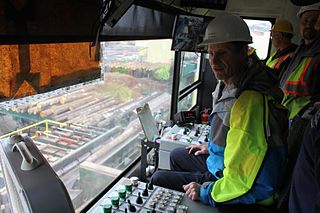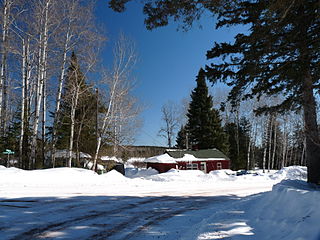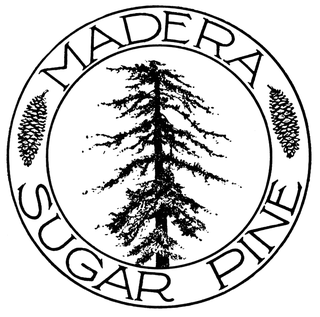
Lumber is wood that has been processed into uniform and useful sizes, including beams and planks or boards. Lumber is mainly used for construction framing, as well as finishing. Lumber has many uses beyond home building. Lumber is sometimes referred to as timber in the United Kingdom, Europe, Australia, and New Zealand, while in other parts of the world the term timber refers specifically to unprocessed wood fiber, such as cut logs or standing trees that have yet to be cut.

Logging is the process of cutting, processing, and moving trees to a location for transport. It may include skidding, on-site processing, and loading of trees or logs onto trucks or skeleton cars. In forestry, the term logging is sometimes used narrowly to describe the logistics of moving wood from the stump to somewhere outside the forest, usually a sawmill or a lumber yard. In common usage, however, the term may cover a range of forestry or silviculture activities.

Engineered wood, also called mass timber, composite wood, human-made wood, or manufactured board, includes a range of derivative wood products which are manufactured by binding or fixing the strands, particles, fibres, or veneers or boards of wood, together with adhesives, or other methods of fixation to form composite material. The panels vary in size but can range upwards of 64 by 8 feet and in the case of cross-laminated timber (CLT) can be of any thickness from a few inches to 16 inches (410 mm) or more. These products are engineered to precise design specifications, which are tested to meet national or international standards and provide uniformity and predictability in their structural performance. Engineered wood products are used in a variety of applications, from home construction to commercial buildings to industrial products. The products can be used for joists and beams that replace steel in many building projects. The term mass timber describes a group of building materials that can replace concrete assemblies.

The Forest Stewardship Council GmbH (FSC) is an international non-profit, multistakeholder organization established in 1993 that promotes responsible management of the world's forests via timber certification. This organization uses a market-based approach to transnational environmental policy.

The Parr Company Inc. is a lumber and building supplies dealer based in Oregon. The Hillsboro, Oregon, based company has 44 locations in Oregon and Washington and is the 18th largest residential building supplies dealer in the United States.

The Sustainable Forestry Initiative (SFI) is a sustainability organization operating in the U.S. and Canada that works across four pillars: standards, conservation, community, and education. SFI was founded in 1994 by the American Forest & Paper Association (AF&PA). SFI is the world's largest single forest certification standard by area. SFI is headquartered in Ottawa and Washington, D.C.

A forest product is any material derived from forestry for direct consumption or commercial use, such as lumber, paper, or fodder for livestock. Wood, by far the dominant product of forests, is used for many purposes, such as wood fuel or the finished structural materials used for the construction of buildings, or as a raw material, in the form of wood pulp, that is used in the production of paper. All other non-wood products derived from forest resources, comprising a broad variety of other forest products, are collectively described as non-timber forest products (NTFP). Non-timber forest products are viewed to have fewer negative effects on forest ecosystem when providing income sources for local community.

Reclaimed lumber is processed wood retrieved from its original application for purposes of subsequent use. Most reclaimed lumber comes from timbers and decking rescued from old barns, factories and warehouses, although some companies use wood from less traditional structures such as boxcars, coal mines and wine barrels. Reclaimed or antique lumber is used primarily for decoration and home building, for example for siding, architectural details, cabinetry, furniture and flooring.

Collins is a family-owned American forest products company that began in operations July 28, 1855. Headquartered in Portland, Oregon, Collins was the first privately owned forest products company in the United States to have all of its hardwood and softwood forests certified by the Forest Stewardship Council (FSC). In addition to its forests and sawmills, Collins also manufactures siding and trim, particleboard, hardwood, and softwood lumber, and operates retail hardware and lumber yards in northern California. Divisions include: Collins Pine Company, Kane Hardwood, Collins Hardwood LLC, Collins Products LLC, Collins Builders Supply, and the Almanor Railroad.

HS Timber Group is an Austrian based company operating in the wood processing industry, lumber trading and bioenergy production. It is one of the leading woodworking business in Europe and employs more than 2,700 people in its headquarters and seven global production units.
The Finkbine-Guild Lumber Company was established to harvest and market the virgin longleaf pine stands of southern Mississippi during the early 20th century. The main sawmills were located in Wiggins and D'Lo, Mississippi. When the local timber supply dwindled, the company tried to utilize redwood trees from California, but that operation failed because of high transportation costs. Other attempts were made at promoting a more diversified use of the cutover timberlands; some ventures were successful while others were not.

The Spruce Production Division was a unit of the United States Army established in 1917 to produce high-quality Sitka spruce timber and other wood products needed to make aircraft for the United States' efforts in World War I. The division was part of the Army Signal Corps's Aviation Section. Its headquarters were in Portland, Oregon, and its main operations center was at Vancouver Barracks in Vancouver, Washington. Workers in the division were members of the Loyal Legion of Loggers and Lumbermen, a union specifically established to support the army's wood production operations.

Morse is an unincorporated community located in the town of Gordon, Ashland County, Wisconsin, United States. Morse is located along the Bad River 7.5 miles (12.1 km) south-southeast of Mellen.

A log pond is a small natural lake or reservoir used for storage of wooden logs in readiness for milling at a sawmill. Although some mill ponds served this purpose for water-powered sawmills, steam-powered sawmills used log ponds for transportation of logs near the mill; and did not require the elevation drop of watermill reservoirs.

The history of the lumber industry in the United States spans from the precolonial period of British timber speculation, subsequent British colonization, and American development into the twenty-first century. Following the near eradication of domestic timber on the British Isles, the abundance of old-growth forests in the New World posed an attractive alternative to importing choice timber from the Baltic via the narrow straits and channels between Denmark and Sweden. The easily available timber proved an incredible resource to early settlers, with both domestic consumption and overseas trade fueling demand. The industry expanded rapidly as Americans logged their way across the country. In this pursuit, hundreds of thousands of indigenous peoples were displaced, murdered, and enslaved for the purpose of the timber industry.

Greenheart Group is a listed multi-national forestry company based in Hong Kong.
Originally a lumber manufacturer, Maibec produces wood products for the construction and landscaping markets. Maibec is a privately held Quebec company owned and operated by the Tardif family from Quebec city. It employs approximately 700 people working in three regions of Quebec: Saint-Pamphile de l’Islet, Saint-Théophile de Beauce, and Saint-Romuald. Maibec was founded in 1946; in 1969 it adopted the name Maibec, a portmanteau of Maine and Quebec. In September 2014, Maibec finalized an agreement to acquire the Fraser Timber lumber mill in Masardis, Maine, United States. Maibec also invested $20 million in 2014 to modernize its mill in Saint-Pamphile.

The Hume-Bennett Lumber Company was a logging operation in the Sequoia National Forest in the late 19th and early 20th centuries. The company and its predecessors were known for building the world's longest log flume and the first multiple-arch hydroelectric dam. However, the company also engaged in destructive clearcutting logging practices, cutting down 8,000 giant sequoias in Converse Basin in a decade-long event that has been described as "the greatest orgy of destructive lumbering in the history of the world."
The wood industry or timber industry is the industry concerned with forestry, logging, timber trade, and the production of primary forest products and wood products and secondary products like wood pulp for the pulp and paper industry. Some of the largest producers are also among the biggest owners of timberland. The wood industry has historically been and continues to be an important sector in many economies.

The Madera Sugar Pine Company was a lumber company that operated in the Sierra Nevada region of California during the late 19th and early 20th centuries. It was known for its use of innovative technologies, such as the first log flume and logging railroad in the southern Sierra, and the adoption of the Steam Donkey engine in commercial logging. The company had a significant impact on the region, leading to the founding of several towns, including Madera, Fish Camp, and Sugar Pine, as well as the growth of Fresno Flats and the formation of Madera County. In addition, the company contributed to the agriculture in California in California through its production of wooden shipping boxes and was involved in a U.S. Supreme Court case related to employer obligations.



















